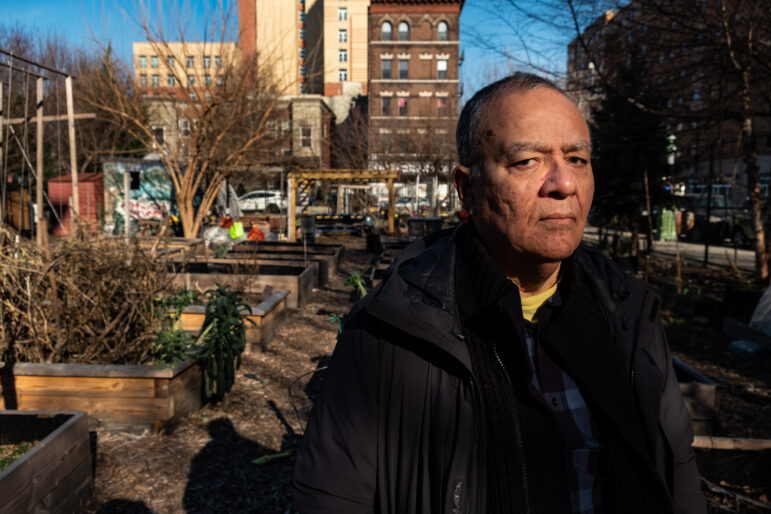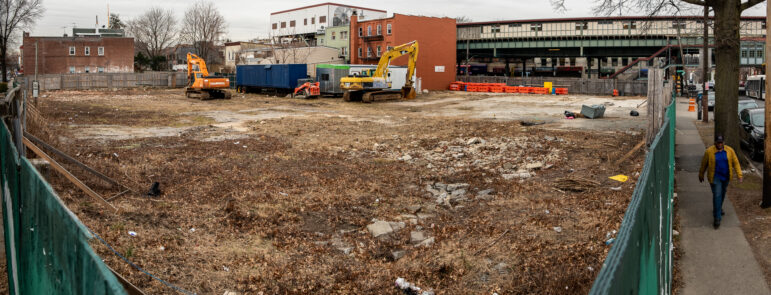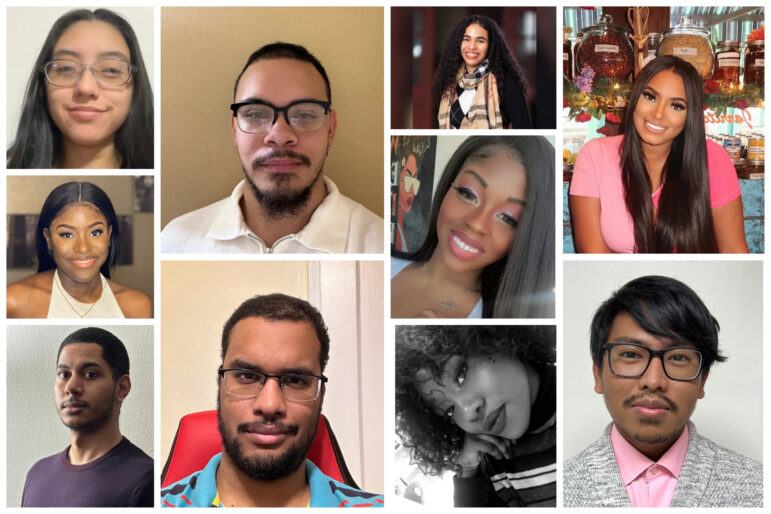During the Fall 2022 semester, Lehman College journalism students conducted an investigation on the prevalence of toxic brownfield sites in The Bronx. Using public information, research into federal lobbying records and interviews with experts and residents, the student journalists set out to understand how this contamination happened and why progress towards remediation was so slow.

Adi Talwar
Angel Garcia at the Rainbow Garden of Life and Health on Melrose Avenue in the South Bronx. He and other neighbors have been pushing the state to clean up the lot next door to the garden, a designated brownfield site.This project was produced by journalism students at CUNY’s Lehman College in The Bronx: Tiara Brownie, Nathaly Cisneros, Patricia Colon, Andrew Figueroa, Aminata Gueye, Ryan Pullido, Pablo Reyes, Emmanuel Valerio, Megan Walls and Anni Rubio. Read more about them here.
Editor’s note: this story was updated after it was originally published to include a response from the NYSDEC.
All across the Bronx there are toxic chemicals in the ground, hazardous enough to the people who live and work nearby that the New York State Department of Environmental Conservation (DEC) has ordered them cleaned up. Yet years—and in some cases decades—after the dangers were identified, the toxic substances are still here, unremediated. Vacant lots near schools and parks, former industrial properties right beside housing, lots that abut community gardens: sites polluted with substances the state identified as harmful and in some cases, cancer-causing, are patchworked across the borough.
As of publication, there are 53 such locations that the DEC has identified as posing a risk to humans and that are classified as under an “active” remediation plan (when we began the project, there were 59). There are scores more sites where remediation is not active. But active doesn’t mean bulldozers are removing noxious soil or that chemicals that leech through vapor in the soil are being neutralized through alternate processes. It just means a slow and halting administrative process is underway.
READ MORE: What is PERC, and Why is There So Much in The Bronx?
Meanwhile, underneath these 53 sites are chemicals and metals that range from harmful to lethal, including benzene, trichloroethylene (TCE), and tetrachloroethylene (PERC). The harms caused by these chemicals range from dizziness and difficulty concentrating to respiratory distress, liver problems, and cancer. Yet despite these dangers, they still remain buried beneath the neighborhoods, many years after being identified.
Editor’s note: an earlier version of this video stated that the DEC press office did respond to requests for comment. To clarify: one person we asked to interview was unavailable. When we asked to interview a different DEC official, the press office responded asking for more information about our query. We regret this error; the piece has been updated.
—Video editing and production by Anni Rubio
During the Fall 2022 semester, Lehman College journalism students conducted an investigation on the prevalence of these toxic brownfield sites in The Bronx. There are similar sites all over the city, 32 in Manhattan, 139 in Brooklyn, 71 in Queens, and 3 in Staten Island, but we concentrated on those in The Bronx.
Using public records from a database maintained by the DEC, interviews with people who lived near contaminated sites and with activists pushing for greater public notification, interviews with experts and research into federal lobbying records, we set out to understand how this contamination happened and why progress towards remediation was so slow. We were interested in the prevalence of these brownfields in low-income communities of color, curious about how historic patterns of discrimination and segregation influenced what got cleaned up and what didn’t, and alarmed that so few people—almost no one—knew about it.
Mostly we wanted to make the information we dug up easier for others to access and understand. Our team created a spreadsheet listing the addresses of all the sites the state listed as “active.” For weeks we read through reports on the chemical composition of soil and the properties of heavy metals and other contaminants. We downloaded 300-page PDFs and scoured them to figure out when property owners and the state first learned a site presented a risk and where plans for clean-up stood. We taught ourselves to parse the jargon and specialized language of environmental remediation and chemistry and translated it into straightforward facts. Each member of the team was responsible for filling out information for several of the sites: who owned it, what the contaminant was, how long it’s been known to the owner and the state, what steps had been taken towards clean-up and when.
Next, the team separated into sections contacting the parties responsible, researching the regulatory history of the most common contaminant (PERC), and speaking to concerned Bronxites. We visited the sites, took pictures, spoke to neighbors, and called elected officials, the DEC, and the U.S. Environmental Protection Agency (EPA).
We decided the best way to tell this story was through a smart map and a video. Watch the video above, or here. Use the map below, or in larger form here. Each dot represents a location in need of remediation. If you hover over the red dot you’ll see who owns the plot, what’s in the soil, and how long it has been on the state’s radar.
—Map by Aminata Gueye
Most of the information comes from public records associated with DEC’s Brownfield Cleanup Program. This was launched in 2003 with the purpose of promoting the cleanup and redevelopment of contaminated properties in New York State. To encourage this, the program provided procedural, legal, and financial incentives to get the cleanups going.
Some of these incentives included a streamlined procedure for characterizing site contaminations and remedies for cleaning them, limited liability for any contamination remaining on the site, as well as tax credits for the costs that occurred during the site cleanup (this includes remediation of groundwater contamination, redevelopment of the site, and anything else that is incurred during the site cleanup, according to according to the Overview of the New York State Brownfields Cleanup Program found from the New York State Comptroller’s website.) In May, Gov. Kathy Hochul signed into law a 10-year extension of the program, including its tax credits, as part of the 2022-23 NYS Budget.
Given how many brownfield sites are in The Bronx, how slow progress is, and how few people know anything about the dangers they pose, some Bronx activists are pressuring the DEC to open a field office in The Bronx so that neighborhood people can more readily get the ear of state officials.
"New York State has a proven track record of successfully investigating the full nature and extent of contamination and cleaning up contamination across New York City and the state, including Brownfield Cleanup Program (BCP) and State Superfund (SSF) sites in the Bronx, as part of DEC’s sustained commitment to protect public health and the environment when threats exists," a DEC spokesperson said in an emailed statement.
"When a cleanup is required, DEC prioritizes the protection of public health by working closely with our partners at the state Department of Health to address any potential exposure pathways and determines the appropriate cleanup that will be fully protective of the environment and the community."
—By Ryan Pullido

Adi Talwar
An empty lot at the corner of 241st Street and Furman Avenue is a Brownfield site.About the reporters:

Tiara Brownie: I'm a senior at Lehman College majoring in journalism with a minor in film and television. I dream of working as a reporter or producer in the media and television field, maybe at News 12 The Bronx or Viacom/BET. An honors student at Lehman College, I consider myself an overachiever when it comes to my education. My hobbies include writing, reading, and photography.
Nathaly Cisneros: I'm a senior at Lehman College, currently studying to obtain my Bachelor of Arts degree in journalism. I have done production work with BronxNet where I was also a social media coordinator. I hope to continue learning production work and learning more about the industry.
Patricia Colon: I'm a native of the South Bronx who now lives in Jersey and commutes to Lehman College. I am majoring in journalism and hope to work in television, covering entertainment and culture.
Andrew Figueroa: A senior at Lehman College, I’m from Puerto Rico but was born and raised in East Harlem. My interest with journalism is to become a sports reporter and to help athletes get exposure.
Aminata Gueye: I am a junior at Lehman College, where I am studying journalism and Africana Studies. I live in Harlem and worked on the DataWrapper map and photography for Buried Beneath.
Ryan Pullido: I'm a senior at Lehman College, who lives in Woodside, Queens, and hopes to pursue a career in investigative journalism. I'm persistent in finding and tracking down story leads. For Buried Beneath I reported on the DEC sites, adding them to the spreadsheet, as well as contacting people from the engineering firms and people from the DEC.
Pablo Reyes: I'm a 22-year-old student reporter native to Bronx, NY, who attends Lehman College and is set to graduate this spring of 2023. Majoring in English with a minor in journalism, my goal is to write my own book series, and as a result I have taken to reading literary works of all kinds to have a greater understanding of literature in general. Recently I have been developing skills in photography, leading to an interest in photojournalism.
Emmanuel Valerio: I'm an undergraduate student majoring in English with a minor in journalism. I was born and spent most of my childhood overseas in the Dominican Republic before making my way to the United States, where I fell in love with storytelling as a whole and chose to pursue it as a career. History is the story of humanity, and I believe it is through journalism that such a tale can be stored and shared with the future.
Megan Walls: I am currently a junior who is majoring in journalism at Lehman College. Living in New York City, particularly in the borough of The Bronx for the majority of my life, I got the chance to experience various types of people and their way of life, and I happened to gain even more knowledge through working on this project with my classmates.
Anni Rubio: is a Lehman College senior majoring in journalism. A photographer and video producer for Lehman's Multimedia Center, she is at work on a video project documenting migration narratives and plans to work in video production and film.









3 thoughts on “Buried Beneath: The Fight to Clean Up Toxic Brownfields in The Bronx”
You students are AWSOME.
Thank you for shedding a light on NYS DEC’s negligence and failure to protect the people of New York.
They have failed to clean up Brownfields everywhere and are more concerned with developers profits than the health and welfare of the people who live near these polluted sites.
You are our future.
And then there are all of the publically unknown contaminated sites that do not appear on any databases because the antiquated reporting obligations do not require disclosure of historic contamination discovered during due diligence.
Impressive work!